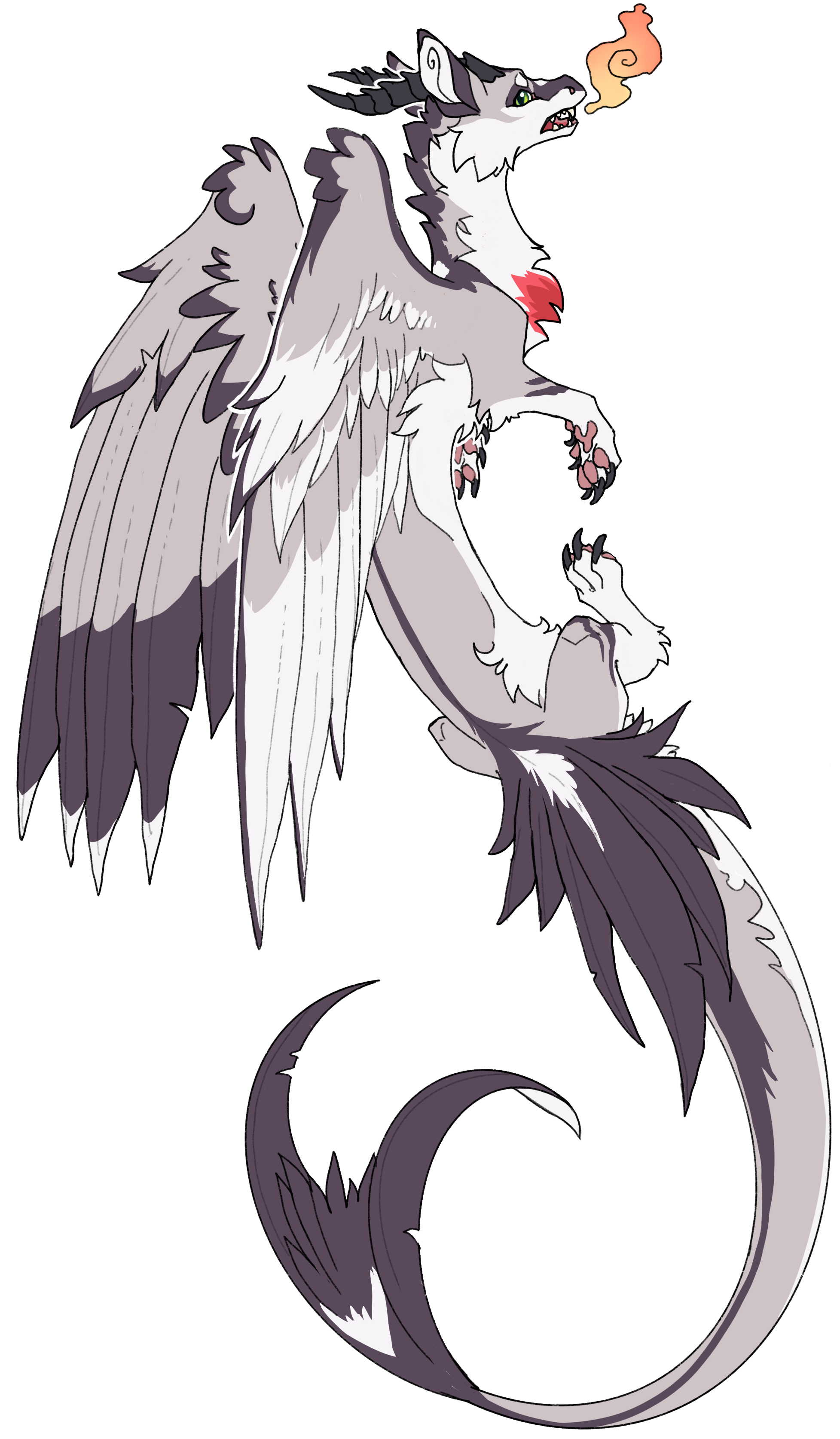
Fisher Dragons
Draconid species • Semi-Closed • Owned by littlenoodledragon
Fisher dragons are a small species of draconid that branched off from an early ancestor between western and eastern dragons. They have retained a long, skinnymorph form and a set of feathered wings. They also developed rump and tail feathers to help make up for their weakened magic-powered flight. Like all draconids, their bones are hollow, lessening their weight to size ratio. Most wild fishers range from 50 to 200 pounds.
Fisher dragons range widely in their colors, wing types, and silhouette. Males are especially colorful and have long tendrils on their muzzles. They also often have ornate feathers meant for attracting mates.
Species Traits
• Fireproof and waterproof fur and feathers, due to an oil secreted by their sebacious glands
• Segmented horns that may be curved multiple times
• Feathered wings, rump, and tail feathers.
• Deer-like external ears.
• Whiskers on male specimens.
• Slightly forked tongue.
• The ability to breath dragonfire.
Morphology and Subspecies
Due to their adaptability, there are a great number of fisher dragon subspecies, with new ones being found often. Subspecies can vary in color, size, plummage shape, and diet preferences. [the section listed "Behavior and Ecology" has more information regarding traits all fisher dragons share.]
Behavior and Ecology
Diet
Fisher dragons are an omnivorous species that mostly specializes preying on fish, crustaceans, molluscs. They will supplement their diet with vegetation (both aquatic and terrestrial, fruit, tubers, mushrooms, and occasionally birds and mammals, depending on the subspecies or food scarcity.
Fishers that supplement their diet more heavily with vegetation tend to have flatter molars for griding plant matter. Ones that are more dependent on a completely piscivorous diet have sharper teeth pointed towards the throat to grip prey.
Hunting Strategies
Different fishers employ different strategies for hunting. A common technique is to sit motionless in the water or at a riverbank waiting for prey with their neck retracted back. Once a prey is spotted, the fisher dragon will move its head back and forth to calculate the position of it's prey before striking it's head forth with their jaws open to capture the prey. Other hunting techniques include paired hunting, where mated fishers will work together to flush the fish within range of each other by slapping their wings on the water's surface. Subspecies that hunt in the sea excel at diving and chasing their prey underwater, and have been recorded holding their breath for up to 15 minutes.
Relationships
Courting
Each breeding season Fisher dragons court their chosen mate by presenting them with items of their hoarding preference. If the other dragon accepts, they launch into an elaborate display of flight, water, and fire, twisting in the air then plummeting into the water before launching back into the air again. This display has been called dragon dancing due to its intricacy.
Breeding
Fishers mostly form monogamous pairings, though some subspecies only come together during the breeding season and may choose a different partner each year.
The breeding season is in late winter, and the female will lay a clutch of one to four eggs in the spring. The incubation period is approximately one month before hatchlings emerge.
Sexual Dimorphism
Males are generally larger and more ornate than females, with longer horns, rump, and tailfeathers. Males of all subspecies have long tendrils on each side of their snouts. These are thought to signal good health to potential mates.
Kinships
Fisher dragons are highly intelligent and bond strongly with other fishers. Territories are fluid and their boundaries are not fiercely protected except during the breeding season, when males become significantly more territorial. But for the majority of the year fishers will frequently come into contact with one another to strengthen social bonds and exhibit play behaviors, such as flight and water dances. Bonded fishers may also exhibit resource sharing when food is scarce.
Hoarding
Fisher dragons hoard just as all dragons do. The majority of them hoard typical objects for dragons, including gems, jewels, precious metals and rocks. Some hoard more peculiar objects, and fishers have been recorded to hoard oddly shaped bones, soft ojects such as blankets, and abandoned human trinkets.
Symbiosis with Dragon birds
Dragon birds (also known as dragon preeners or dragon crows) are a species of bird that has evolved symbiotically alongside dragons. Dragon birds eat ticks and small insects that attempt to parasitize dragon fur and scales. They appear to have corvid-level intelligence, and have been documented seeking out hoard items their dragon prefers. In exchange, dragons provide protection and food. Fisher dragons are especially fond of their dragon birds, and will often provide them with their excess food. Fisher dragon fur also makes for exceptional nest material due to its waterproof and fireproof characteristics.
Lifespan
Though it varies slightly by subspecies, Fishers live around 150 years. Hatchlings will remain with both parents until they reach sexual maturity at 10 years, at which point they venture off on their own to establish a territory and begin looking for a mate. A mated pair will forage, hunt, and in some subspecies migrate together. Sexual sterility is reached at about 125 years.
Thermoregulation
Fisher dragons are mesothermic, they can expend energy to maintain their body temperature at the cost of increasing their metabolic rate and burning calories, or reduce their body temperature to their ambient surroundings and enter torpor, a state of inactivity, if it is cold and there is a lack of food.

Habitat and Range
Fisher dragons are widespread and subspecies can be found on all continents except for the northnermost poles. They inhabit areas with easy access to nearby rivers, lakes, or oceansides. Some species are migratory and adaptable to many different environments.
Domestication
Due to their amicable nature and relatively small size compared to western dragons and drakes, fisher dragons are a popular choice for domestication as pets or workers. While some wild subspecies can be tamed, completely domesticated subspecies are more popular. These subspecies have been bred to be docile and much smaller than their wild counterparts, sometimes as small as 15 pounds. There are some of the largest subspecies that are bred as a means of flight transportation, but this is less common as small western dragons have a stronger back and wider base for a saddle. The most prevalent use of domestic fisher dragons is as a fishing partner. Due to their hunting prowess in the water, they are a skilled companion for fisherman.
HTML by Eggy


